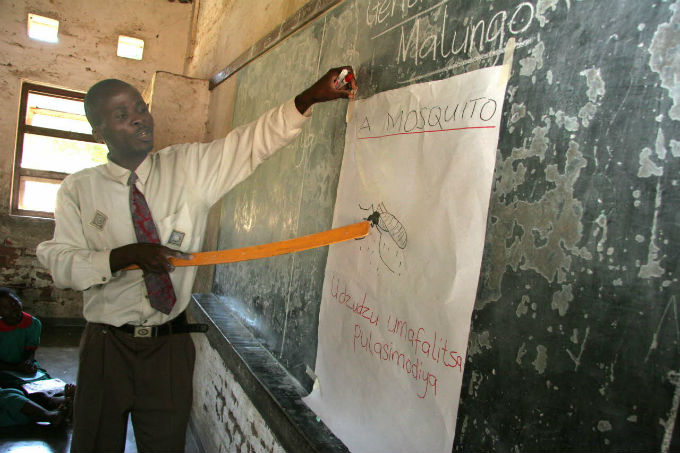AI
AI in the Fight Against Malaria
February 5, 2018 | Written by: Oliver Bent
Categorized: AI
Share this post:
Bed nets, insecticides and repellents are all effective intervention strategies to control the spread of malaria, but with a continuously dwindling budget, how can public officials and policy makers know what to use, where and when, to be most effective?
Malaria is caused by parasites that are transmitted to people through the bites of infected mosquitoes. While it’s endemic in sub-Saharan Africa (SSA), nearly half of the world’s population is at risk. According to the World Health Organization in 2015, there were roughly 212 million malaria cases and an estimated 429,000 malaria deaths.
Malaria control measures have led to a 29% reduction in mortality rates since 2010, I’d personally like to see this statistic eradicated, the tools of machine learning (ML) and more recently artificial intelligence (AI) may provide some potential answers.

A teacher explains to students about mosquitoes and malaria. CREDIT: WHO/S. Hollyman
Today at the Innovative Applications for Artificial Intelligence (AAAI-IAAI) conference located in New Orleans, I am privileged to present our recent work ‘Novel Exploration Techniques (NETs) for Malaria Policy Interventions.’ Conducted in collaboration between IBM Research – Africa and the University of Oxford, we have begun to use machine intelligence to augment the decision-making abilities of officials, and explore more effective malaria policy interventions.
Our work proposes the use of different AI algorithms or ‘agents’ to determine the most effective intervention strategies for specific locations. This was possible due to publicly available research and models (OpenMalaria). The OpenMalaria simulation model can be used by computational agents to explore “what if” scenarios and learn new, more effective policies for the control of the disease.
Our approach applies multiple AI agents to determine more effective malaria policies based on a combination of; distributing long-lasting insecticide-treated nets; and performing indoor residual spraying programs. We ran these computational experiments to simulate a region in Western Kenya over a five-year intervention period into the future.
Using a combination of advanced computer infrastructure and AI we can demonstrate that it’s possible to determine higher performing future intervention strategies for a particular region. This is important, because as with anything, people find it difficult to deal with vast strategy spaces and sometimes our decisions can be prejudiced from past experience, lack of time or influence. We’ve developed the AI agents as “expert advisors”, to help support policy makers, looking for more cost-effective intervention strategies.
The cost effectiveness of malaria intervention strategies is significant; given finite, distributed and uncertain investment in the elimination of malaria, AI may be able to level the playing field and coordinate how we can do the most good for the greatest number of people. For example, a 2017 study reported that insecticide-treated nets are consistently the most cost effective intervention across a range of transmission locations.
Yet, our results suggest that for simulated scenarios in Western Kenya, it may be more cost effective to perform indoor residual spraying programs for a small proportion of households, instead of continuing to scale the deployment of insecticide-treated nets.
We have treated the particular challenge of determining the most cost-effective malaria interventions as a stochastic multi-armed bandit problem. Since we assume any strategy is to be implemented five years into the future, this reduces the problem to identifying which single policy as a combination of interventions is most cost effective.
At the same time as exploring novel, high-performing policies, we wish to reduce uncertainty given the stochasticity in the results which support any decision made.
Therefore, “Bandit algorithms” which take into account uncertainty were a natural fit as well as giving comparison with other techniques including Genetic Algorithms and Policy-Gradients from Reinforcement Learning.
While we have only just started to scratch the surface of possibilities of how AI may be used to tackle such grand challenges, we’re continuing to research how we can achieve more nuanced decisions through training machines to understand the impacts of seasonality; explore more intervention options; target interventions to specific populations; deploy across locations; and account for dynamic changes in the environment as we observe new real-world data. This I believe would bring us closer to the objective of malaria eradication with AI!
Luckily though, we don’t believe we have to do this alone or in isolation. We have been working to bring this work and the tools we’ve developed to the cloud, leveraging even greater computing resources, and geographical independence. Hopefully all of this will inspire other researchers to engage with the problem too.
Novel Exploration Techniques (NETs) for Malaria Policy InterventionsOliver Bent, Sekou L. Remy, Stephen Roberts, Aisha Walcott-Bryant, https://arxiv.org/abs/1712.00428

Scientist, IBM Research - Africa
Making the workplace safe for employees living with HIV
The recent promising news about Covid-19 vaccines is in sharp contrast to the absence of a vaccine for HIV, despite decades of research. Unlike Covid-19 with a single viral isolate that shows minimal diversity, HIV circulates in a wide range of strains that so far have proven impervious to a single vaccine. Fortunately, more people […]
Call for Code for Racial Justice Needs You: Join the Movement
IBM has never avoided taking on big challenges. At IBM, we are privileged to drive impact at scale. We take on challenges that transform our clients, impact people’s lives and innovate for future generations as we strive to effect systematic societal change. Over the course of our 109-year history, the evidence has become clear that […]
A New Wave: Transforming Our Understanding of Ocean Health
Humans have been plying the seas throughout history. But it wasn’t until the late 19th century that we began to truly study the ocean itself. An expedition in 1872 to 1876, by the Challenger, a converted Royal Navy gunship, traveled nearly 70,000 nautical miles and catalogued over 4,000 previously unknown species, building the foundations for modern […]


